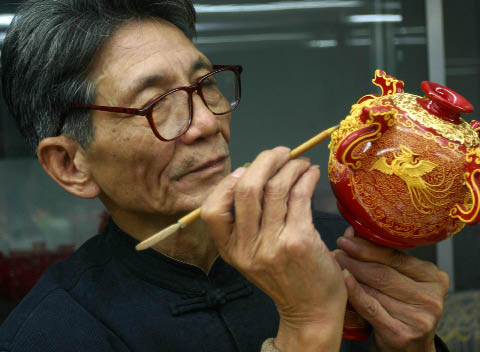| Lacquer Thread Sculpture
By staff reporter XING WEN
|
 |
|
Cai Shuikuang at work. |
LACQUER thread sculpture is a traditional folk handicraft of Fujian Province. It is especially popular in Xiamen and Quanzhou of this southeast coastal province.
The delicate and demanding craft derived from decorations on Buddhist statues and evolved into an independent art form some 300 years ago. In the Tang Dynasty (618-907), the prevalence of Buddhism stimulated the craftsmanship for religious statues, which were lavishly decorated with colorful painting of varied kinds. During the Song (960-1279) and the Yuan dynasties (1279-1368), sculptors began to use lacquer threads to outline patterns on the clothing and headwear of the figures they created, giving their works a tri-dimensional aspect. The technique was also widely applied to the modeling of native gods – Mazu and Baosheng Dadi, the divine doctor. Both are found in shrines all over Fujian.
It was not until the Qing Dynasty (1644-1911) that lacquer thread sculpture came into its heyday. The making required months of hard work, and up-scale products were often coated with pure gold. These artworks were especially valuable and so were well-received among the upper class as symbols of wealth and high social status. Lacquer thread sculpting thrived in Fujian and soon made its way to the rest of the country. The Fujian people's merchant tradition and tendency to seek their fortunes abroad also helped to spread the craft's popularity beyond China.
Making a lacquer thread sculpture involves two major procedures – carving the figurine and then decorating it with lacquer threads. Most craftsmen are skillful in only one of them, so have to team up with others. However, the Cai family in Xiamen is proficient in the entire process and has produced a number of masters in the field.
The Cai family has been dedicated to this for 13 generations and is recognized for its leadership in the craft. The family brought the skill to new heights in each respective age. Cai Wenpei, Cai Shuikuang and Cai Shidong were the most prominent of the 11th, 12th and 13th generation of heirs. In Xiamen, a museum established by the Cais showcases the history, production process and classic artworks of lacquer thread sculpture.
Fujian is rich in camphorwood, a lustrous wood of even texture and a prime material for carving. The carved body is polished several times since lacquer threads must be attached on a very clean surface. Artisans first apply a mixture of fine soil and gelatin over its surface to fill in any small cracks in the wood. Second, they wrap the figure in cotton or silk and lacquer it. This protects the wood from rot and deformation. The cloth used must be cut into strips so that uneven surfaces can be closely sealed. The silt and gelatin mixture is applied again before the body is finally finished with sand paper. The smoother the surface is, the brighter the lacquer decorations will be.
| 